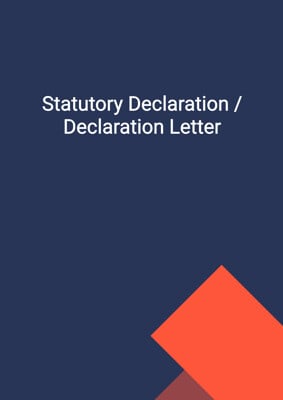How to Tailor the Document for Your Need?
01
Create Document
Click "Create Document" button and the document will be prepared with your account details automatically filled in.
02
Fill Information
Please fill in any additional information by following the step-by-step guide on the left hand side of the preview document and click the "Next" button.
03
Get Document
When you are done, click the "Get Document" button and you can download the document in Word or PDF format.
04
Review Document
Please review the document carefully and make any final modifications to ensure that the details are correct before sending to the addressee.
Document Preview
Document Description
The document titled 'Letter of Undertaking' is a formal letter that serves as a written commitment from one party to another. It is commonly used in business transactions to outline the terms and conditions of an agreement between a vendor and a purchaser. The importance of this document lies in its ability to provide legal protection and clarity to both parties involved.
The entire document consists of several sections that cover different aspects of the transaction. The first section is the introduction, which includes the names and addresses of the parties involved, the date of the letter, and a salutation. This sets the tone for the rest of the document and establishes the context of the undertaking.
The next section is the 'Completion Monies' section, which addresses the funds to be paid by the purchaser to the vendor upon completion of the transaction. It clarifies whether the funds are already held in a client account or will be transferred shortly. It also outlines the conditions under which the completion monies can be returned to the purchaser before completion.
The following section is the 'Release of Completion Monies to the Vendor at Completion' section. This section confirms that upon receipt of the instruction letter, the completion monies will be released to the vendor and the settlement process will begin. It also mentions the accrual of interest on the completion monies and how it will be distributed between the purchaser and the vendor.
The 'Interest' section further elaborates on the calculation and distribution of interest earned on the completion monies. It specifies that interest earned before completion will be for the purchaser's account, while interest earned after completion will be for the vendor's account. It also clarifies that if completion does not occur, all interest earned will be for the purchaser's account.
The 'Settlement of Completion Monies Following Completion' section outlines the steps to be taken after completion to transfer the completion monies (including any accrued interest) to the vendor's designated account. It mentions that if any monies to be transferred are on deposit, the transfer instructions will be delayed until the maturity date.
The 'Liability' section states that the letter of undertaking does not hold the issuing party liable for any shortfall in the completion monies or any other loss, cost, or liability caused by external factors such as banks or financial institutions. It also authorizes the deduction of bank charges, taxes, or withholdings from the monies held or to be paid.
The 'General Clause' section covers miscellaneous provisions, including the legality of instructions and payments, the role of the issuing party as a trustee or agent, and the reliance on written instructions. It also clarifies that the issuing party is not responsible for the distribution of monies among the beneficiaries.
The 'Amendment' section states that any changes to the letter of undertaking must be made in writing and signed by all parties involved. The 'Severability' section ensures that if any clause or term is deemed void or unenforceable, the remaining clauses and terms will still be valid.
The 'Definition' section provides a definition for the term 'business day' and specifies that the jurisdiction state law governs the terms of the letter. It also designates the jurisdiction state courts as the exclusive jurisdiction for settling any disputes related to the letter.
The last section includes the signature block for party 3, who is instructed to give the undertakings outlined in the letter. It also includes a copy of the letter to be sent to party 2 for their records. The document concludes with the agreement, signature, and acceptance by party 1.
In summary, the 'Letter of Undertaking' is a comprehensive document that covers various aspects of a business transaction. It provides a detailed framework for the completion of the transaction, the release of funds, the calculation and distribution of interest, and the liability of the issuing party. It is essential for both parties to understand and adhere to the terms outlined in the letter to ensure a smooth and legally binding transaction.
How to use this document?
1. Provide information: Enter the names and addresses of the parties involved in the agreement, including their principal place of business. This ensures clear identification of both parties.
2. Clarify completion monies: Determine whether the completion monies are already held in a client account or will be transferred shortly. If held, confirm the amount and the conditions under which the monies can be returned to the purchaser before completion.
3. Release of completion monies: Upon receipt of the instruction letter, the completion monies will be released to the vendor. Ensure that the settlement process is initiated promptly and that the completion monies are held to the vendor's order.
4. Calculate interest: Understand the calculation and distribution of interest earned on the completion monies. Determine the entitlement of the purchaser and the vendor to accrued interest before and after completion. Clarify that if completion does not occur, all interest earned will be for the purchaser's account.
5. Settle completion monies: After completion, transfer the completion monies (including any accrued interest) to the vendor's designated account. If any monies are on deposit, delay the transfer instructions until the maturity date.
6. Address liability: Understand that the issuing party is not liable for any shortfall in the completion monies or any other loss, cost, or liability caused by external factors. Authorize the deduction of bank charges, taxes, or withholdings from the monies held or to be paid.
7. Miscellaneous provisions: Familiarize yourself with the general clauses, including the legality of instructions and payments, the role of the issuing party, and the reliance on written instructions. Acknowledge that the issuing party is not responsible for the distribution of monies among the beneficiaries.
8. Amendment: Any changes to the letter of undertaking must be made in writing and signed by all parties involved. Ensure that any amendments are properly documented.
9. Understand severability: If any clause or term is deemed void or unenforceable, the remaining clauses and terms will still be valid. Be aware of the impact of severability on the enforceability of the letter.
10. Jurisdiction and dispute resolution: Recognize that the terms of the letter are governed by jurisdiction state law. Agree that the jurisdiction state courts have exclusive jurisdiction to settle any disputes arising from the letter.
It is important to follow these steps to ensure the proper use and implementation of the 'Letter of Undertaking' in a business transaction. By understanding the details and adhering to the guidance provided, both parties can protect their interests and facilitate a successful completion of the transaction.
Not the right document?
Don’t worry, we have thousands of documents for you to choose from:








